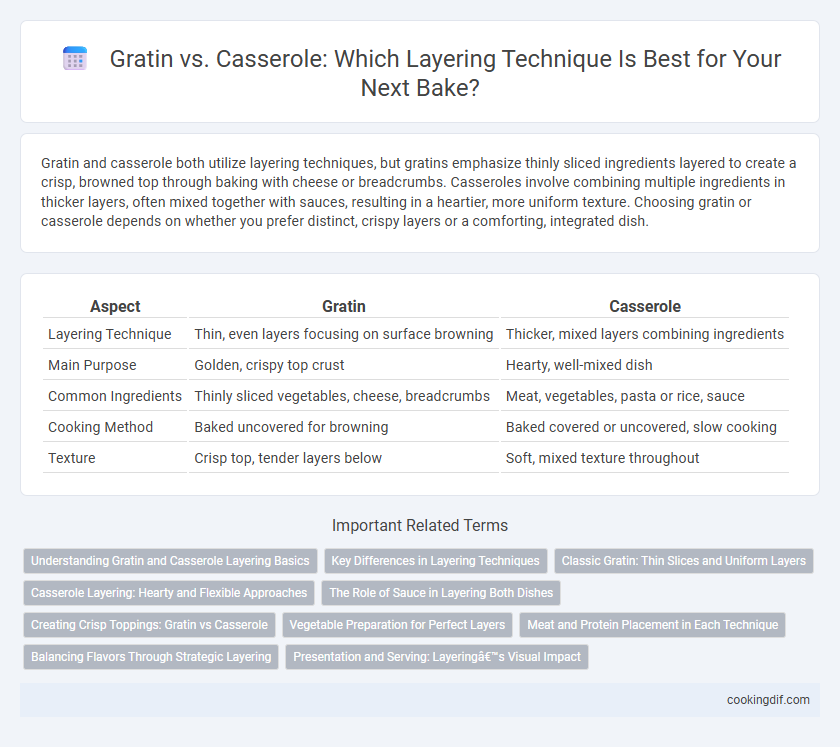Gratin and casserole both utilize layering techniques, but gratins emphasize thinly sliced ingredients layered to create a crisp, browned top through baking with cheese or breadcrumbs. Casseroles involve combining multiple ingredients in thicker layers, often mixed together with sauces, resulting in a heartier, more uniform texture. Choosing gratin or casserole depends on whether you prefer distinct, crispy layers or a comforting, integrated dish.
Table of Comparison
| Aspect | Gratin | Casserole |
|---|---|---|
| Layering Technique | Thin, even layers focusing on surface browning | Thicker, mixed layers combining ingredients |
| Main Purpose | Golden, crispy top crust | Hearty, well-mixed dish |
| Common Ingredients | Thinly sliced vegetables, cheese, breadcrumbs | Meat, vegetables, pasta or rice, sauce |
| Cooking Method | Baked uncovered for browning | Baked covered or uncovered, slow cooking |
| Texture | Crisp top, tender layers below | Soft, mixed texture throughout |
Understanding Gratin and Casserole Layering Basics
Gratin and casserole layering techniques differ primarily in texture and moisture control, with gratin focusing on thinly sliced ingredients arranged in overlapping layers to achieve a crispy, browned top under high heat. Casseroles typically combine chunks or mixed ingredients in a deeper dish, allowing flavors to meld through baking with a moist interior and a baked crust. Mastering gratin layering involves precise slicing and even spacing to ensure uniform cooking, while casserole layering emphasizes a balanced distribution of ingredients to maintain cohesive structure and consistent baking.
Key Differences in Layering Techniques
Gratin and casserole differ significantly in their layering techniques; gratins typically feature thin, uniformly sliced ingredients carefully layered to create a crisp, browned top, while casseroles often combine ingredients more loosely, resulting in a homogenous texture throughout. Gratin layers emphasize surface exposure for optimal browning, often using potatoes, cheese, or vegetables arranged in overlapping patterns. Casserole layering prioritizes mixing various components like proteins, vegetables, and sauces to ensure even cooking and moisture distribution across the dish.
Classic Gratin: Thin Slices and Uniform Layers
Classic gratin relies on thin slices of ingredients like potatoes or vegetables arranged in uniform layers to ensure even cooking and a crispy top crust. This precise layering technique differentiates gratin from casseroles, which often feature mixed or chunkier components. Achieving consistent thickness in slices enhances texture and flavor absorption, making the gratin distinctively tender yet crispy.
Casserole Layering: Hearty and Flexible Approaches
Casserole layering techniques emphasize hearty and flexible approaches that combine diverse ingredients like meats, vegetables, cheeses, and sauces in distinct strata, creating depth of flavor and texture. Unlike gratins, which typically feature a uniform, thin layering topped with browned breadcrumbs or cheese, casseroles allow for substantial, multi-layered assemblies that meld during baking. This method supports customization and variety, making casseroles ideal for family meals requiring durable, satisfying dishes with rich, cohesive flavors.
The Role of Sauce in Layering Both Dishes
In gratins, sauce plays a crucial role by creating a creamy, often cheesy layer that binds ingredients and forms a golden crust, typically using bechamel or cream-based sauces. Casseroles rely on thicker, often tomato-based or broth-infused sauces that permeate layers of meat, vegetables, and starches to ensure even moisture distribution and flavor melding. The different sauce consistencies directly influence the texture and structural integrity during the baking process in both dishes.
Creating Crisp Toppings: Gratin vs Casserole
Gratin excels in creating crisp toppings through its use of breadcrumbs, cheese, and butter that brown evenly under high heat, producing a golden, crunchy crust. Casseroles often prioritize tender, layered fillings and may not achieve the same level of topping crispness due to their typically moist ingredients and lower baking temperatures. Achieving a perfect crisp requires controlling moisture and heat exposure, making gratin the preferred method for a distinctive, textured finish.
Vegetable Preparation for Perfect Layers
Gratin and casserole differ significantly in layering techniques, especially in vegetable preparation. Gratin requires thinly sliced vegetables arranged in precise, overlapping layers to ensure even cooking and a crispy, golden top, while casseroles typically involve chopped or mixed vegetables that create a more homogenous texture. Mastering the vegetable preparation by controlling slice thickness and layering consistency is crucial for achieving perfect layers and optimal flavor contrast in both dishes.
Meat and Protein Placement in Each Technique
Gratin typically layers thin slices of meat or protein on the bottom or middle, allowing the flavors to meld with creamy sauces and cheese topping. Casseroles often integrate chunks of meat or protein evenly throughout the dish, blending with vegetables and starches for balanced texture and taste. The gratin method emphasizes a crisp, browned crust while casseroles focus on uniform heat distribution for tender, hearty servings.
Balancing Flavors Through Strategic Layering
Gratin and casserole both utilize strategic layering techniques to balance flavors, but gratins emphasize a thinner layering with a focus on crispy, browned toppings that intensify textures and contrasts. Casseroles typically involve thicker, more substantial layers where ingredients like meats, vegetables, and sauces are evenly distributed to create harmonious, melded flavors throughout the dish. Achieving optimal flavor balance depends on controlling ingredient density and layering order, with gratins favoring crisp top layers and casseroles focusing on integrated, soft layers.
Presentation and Serving: Layering’s Visual Impact
Gratin and casserole differ significantly in their layering presentation; gratins emphasize a crisp, browned top layer that adds visual appeal and texture contrast. The layering in gratins is typically more refined and uniform, enhancing the dish's aesthetic when served, while casseroles often feature mixed or loosely layered ingredients resulting in a heartier, less structured appearance. Serving a gratin highlights its golden crust and neat layers, making it visually striking, whereas casseroles present a more rustic and comforting look ideal for casual dining.
Gratin vs Casserole for layering technique Infographic

 cookingdif.com
cookingdif.com